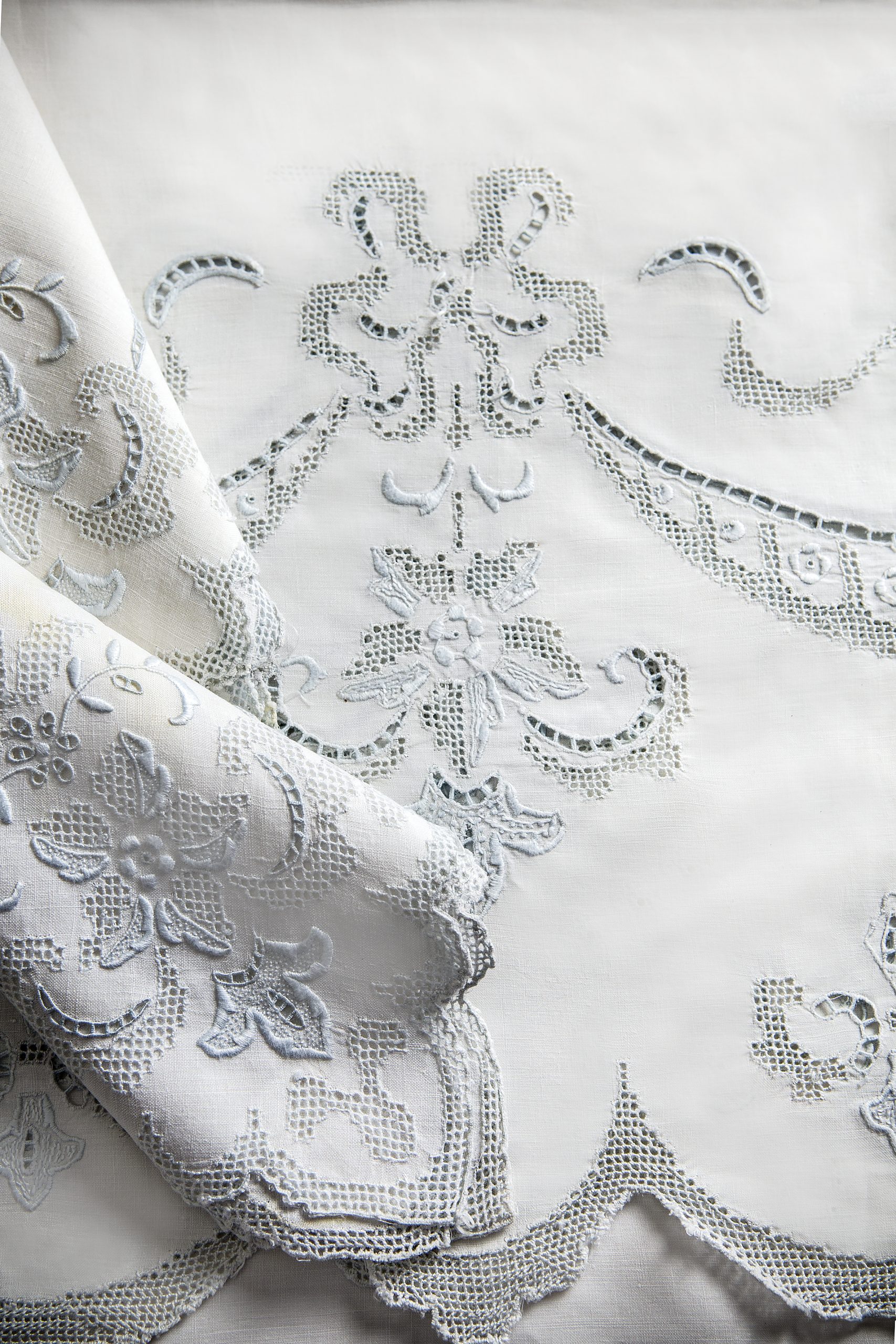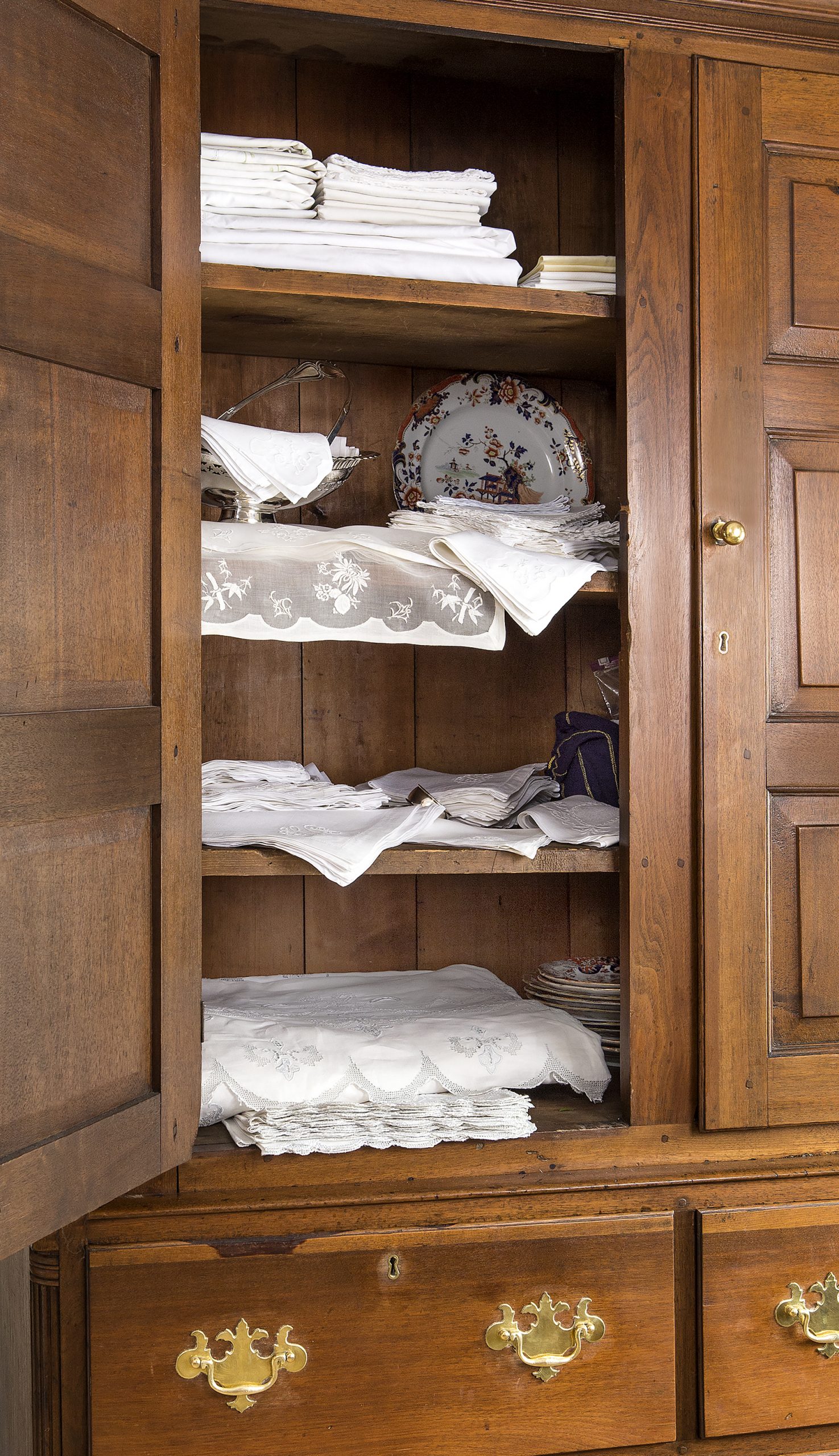
So much of the joy of a holiday meal lies in the traditions that families share year after year: offering a special blessing, placing tapers in silver candlesticks passed from generation to generation, finishing with Grandmother’s special dessert. Providing a backdrop to it all, though, are the unsung heroes of the table: the fancy napkins, tablecloth, or placemats, which, crisp and pristine at the beginning of the feast, are destined to end the evening thoroughly humbled by assailants such as red wine, gravy, lipstick, and salad dressing.
Like any superhero, though, table linens were made to bounce back from even the most colorful holiday food offensive. That’s because although they are beautiful, fine napkins and tablecloths — even antiques — were made to be used, often in surprising ways.
“Many of the older tablecloths in our collection are actually knitted or crocheted, meaning they were meant for the bed or the table,” says Christian Cicimurri, curator of collections for the University of South Carolina’s McKissick Museum. “Later, we see a lot of beautiful embellishments, including embroidery, cross-stitch and, around the 1930s crocheted panels and medallions. The Salley family donated a large collection of beautiful table linens that were created from the late 1800s through the mid-1900s; one set is decorated with cream-colored tassels. The President and Mrs. McKissick had a set of napkins that were embroidered with gamecocks.” The museum building is named for James Rion McKissick, one of Carolina’s most beloved presidents who lay in repose there after his sudden death in 1944.
The Tradition of Fine Linens
During Colonial times, the ability to create and decorate garments using tiny, even stitches was seen as the sign of a good wife. But it went further than that. “It sounds strange today, but activities like needlework were also encouraged because they placed women’s bodies in a position that was pleasing to the eye,” says Christian.
Traditionally, fine linens were also a large part of the trousseau. Sewn from fine quality cotton or linen, these linens, when properly cared for, are meant to last for decades.
“Antique and vintage linens are special because their quality is unsurpassed. Women spent a vast amount of time sewing, hemming, and embellishing these textiles by hand, stitch by stitch,” says Lidy Baars, an antique specialist who owns French Garden House in Huntington Beach, California. “They also bring the beauty of the past into your daily life and impart a gracious sense of welcome to your home.”
Napkin Etiquette
Measuring at about 24 inches square, dinner napkins are normally folded three times to create a smaller square, then in half to form a rectangle. If the napkin is monogrammed, it should be folded so that the monogram ends up in the lower left corner of the napkin; even without a monogram, the napkin should be folded so that it opens to the right, as if paging backwards in a book. Smaller napkins are usually reserved for lunch.
Whether you’re using a tablecloth or place mats, space between guests should be ample enough to allow chairs to easily move in and out, but not so generous that conversation is difficult. Napkins should be placed either atop the service plate or to the left of the forks. For an informal meal, the napkin may be rolled into a napkin ring; position it in the center of the place setting.
Napkins go on laps, and should stay there, unfolded partway, (when they’re not being used) until you have finished eating. At the end of the meal, or if you need to excuse yourself during the meal, place your napkin, folded to hide any stains, to the left of your plate.

Linen Care
Long before dry cleaners, Shout, and Wine Away had been created, savvy hostesses used table salt, poured liberally over the still-wet spill, to simultaneously keep the dinner going and stain from setting. Next, linens were placed in a container of cold water and soaked overnight. The next day, they’d be washed and set outside to dry in the sunshine.
These days, experts suggest arming yourself with a stain remover stick or bar of Fels-Naptha soap, which was invented in 1893 specifically for this purpose, and after lunch or dinner has ended, going over every inch of the tablecloth and napkins, treating each stain as you go. (To protect your table from stains and, ultimately, the Stain Stick, consider using a thin liner underneath the tablecloth.) Next, place the soiled linens into your washing machine, set it on a cold cycle, and turn it on. Once it has filled, hit pause and let the linens rest in the cold water overnight. If your washer doesn’t fill with enough water to keep the linens wet, soak them in a bathtub or clean utility sink. If you’ve used linen cocktail napkins, add them as well, even if they don’t look dirty: left alone, invisible splashes of white wine, tonic, or clear sugared soft drinks will oxidize into tiny brown spots that are remarkably resistant to treatment.
While the overnight soak may seem like an extra step, it’s one worth taking: not only will stains loosen, but as the fibers are hydrated, they’ll be more likely to shake off dirt and stains. Some experts recommend soaking for several days if you have stains that particularly concern you, changing out the water as it dirties, before actually cleaning the piece. Prior to washing, give each piece a final check, gently rubbing to remove any lingering spots.
According to Stu Bloom, who owns Rave FabriCARE in Scottsdale, Arizona, the challenge comes with oil-based stains, which, like sugar, can oxidize into brown spots during storage. “If you’ve cleaned the stain yourself, check the piece about six weeks prior to using it,” he notes. “That way, if the stain has oxidized, your cleaner will have enough time to get it out.”
Vintage linens are often plagued by general yellowing, which can be caused by the breakdown of the finishing chemical often applied to fabric as well as contact with wood, paper, plastic, and cardboard. Though bleach may seem like a no-brainer, it’s much too harsh and will eventually turn the fabric even more yellow before burning holes into it. Instead, go old school.
“The tried and true centuries-old method to try to remove the yellowing is to pour lemon juice through wet linen and sprinkle with salt all over, then place in the sun for several hours,” says Lidy. “I suggest you lay your linen on the grass, being careful that there is nothing underneath that will stain the linen. This was common practice long ago; housewives laid out their washing in a field to dry and ‘bleach’ in the sun. Rinse, and rinse again. Be sure to remove all traces of the lemon and salt. Then hang to dry on a clothesline, or if the weather is warm, simply lay your linen back on your grass to dry as the chlorophyll in the grass will act as a natural brightener.”
If your linens emerge from the washing machine free of stains or spots, it’s possible to dry them in such a way that you can avoid ironing them. Wet napkins can be snapped, fluffed, and massaged smooth; towel-covered chair backs will allow them to dry without creasing. For tablecloths, prepare a line of chairs as long as the tablecloth and fold a thick towel across the top of each to protect the chair from getting wet. Next, gently fold the tablecloth lengthwise to match the width of the chair backs and, with a partner, lay the folded cloth over the backs.
If you’re not using your linens again soon, Christian suggests storing them wrapped in acid-free tissue paper, either flat or rolled around a tube that has also been covered in acid-free paper. “Don’t stack them too high or the ones on the bottom will crease,” she says. They may be placed in a closet or wooden chest but never in a plastic bin.
The most important point is to remember to use them. Like silver flatware, they’re not breakable and will add beauty to your table and joy to your meal. Keeping them stored away defeats their lovely purpose.
How to Iron Vintage Linens
Prefer perfectly smooth linens? Lidy Baars uses vintage linen napkins every day. Here’s how she irons them.
1. Buy the best iron you can. This sounds obvious but really isn’t. I’ve gone through many irons that just didn’t perform. They didn’t get hot enough.
2. Try to time your ironing so that your pieces are still damp. This will make it much easier to press out wrinkles. I have a spray bottle of water handy, spray the piece, and roll it up in a little bundle, just like my Grandmother used to do. I leave the little bundles at the edge of my ironing board until it’s “their” turn.
3. Your No. 1 goal in ironing is to iron your item completely dry. Completely. If you leave them even slightly damp, linens happily get wrinkled again as they dry up. Since steaming adds moisture, be sure to turn off your steam option when ironing antique linens.
4. Always try to iron on the wrong side of the fabric. For embroidery, lay a white terry towel on the ironing board, and press the piece upside down. You want to fluff up the embroidery, not flatten it down. Doing this upside down also avoids catching the tip of the iron in the delicate embroidery work.
5. Iron at the hottest temperature you can. Be careful not to scorch linens, but cottons and linens can be ironed quite hot.
6. Don’t iron in the creases. This can actually break the threads. Just turn over and run your thumb over it, a technique called finger pressing that gives a crease but doesn’t damage the threads and fibers.
7. After you have ironed, hang your linens up on a drying rack so that any residual moisture has a chance to evaporate completely. You can drape linens on the backs of chairs, over your towel bars, flat on your guest room beds, whatever works for you, as long as you let them “rest” for a while.










